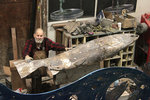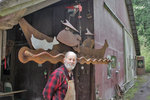Tom Jay of The Lateral Line Gallery and Studio in Chimacum is completing a project for Cove Park, a community pocket park near the Fauntleroy ferry terminal in West Seattle.
Jay, 72, is a master …
This item is available in full to subscribers.
We have recently launched a new and improved website. To continue reading, you will need to either log into your subscriber account, or purchase a new subscription.
If you had an active account on our previous website, then you have an account here. Simply reset your password to regain access to your account.
If you did not have an account on our previous website, but are a current print subscriber, click here to set up your website account.
Otherwise, click here to view your options for subscribing.
* Having trouble? Call our circulation department at 360-385-2900, or email our support.
Please log in to continue |
|


Tom Jay of The Lateral Line Gallery and Studio in Chimacum is completing a project for Cove Park, a community pocket park near the Fauntleroy ferry terminal in West Seattle.
Jay, 72, is a master bronze caster who has run a casting studio for more than 40 years.
The sculptures in his current project for Fauntleroy “celebrate salmon as a totem for the whole Northwest,” he said. Near the park is a stream that is undergoing restoration efforts; “they’re trying to get salmon back,” he said, which is another reason for the salmon motif.
He's been working on this commission for about two years. The larger pieces are being shipped to Fauntleroy on April 14.
One is a bench shaped like a giant, curving female coho salmon, as if a 7-and-a-half-foot-long bronze fish were arrested in mid-swim and laid on its side. Made of bronze and cast in three sections using the lost-wax technique, the bench weighs about 300 pounds. It’s supported by a big stainless pipe that meets the fish just forward of its tail, goes up, turns 90 degrees and extends through the body of the fish, where it’s welded to supporting sections inside, “designed like an airplane wing,” Jay said. When the bench is installed at the park, the exposed part of the support pipe is to be concealed by one or two “fake rocks” made of concrete.
The bronze salmon bench won’t be dyed. “I’m just going to leave it gold,” Jay said. “I’ll wax it and give them a maintenance program,” a set of instructions that involves waxing the piece every six months.
He’s also making schools, or groups, of cast salmon that he’ll mount on posts to be set into salal and other native greenery so as to appear to be “swimming through the landscape.”
SALMON GATE
Jay has also crafted an aluminum gate, 25 feet long and 8 feet high, that evokes a stream, with a curving top edge, leaf-shaped cutouts and salmon suspended in the blue “water,” which are "dyed in their spawning colors."
On a recent afternoon, Jay was hard at work in his Chimacum studio, dyeing the aluminum a brilliant riparian blue. He said he plans to take a scrubbing pad to it afterward, then cover it with epoxy to protect it from the elements and from graffiti.
Sockeye, silver, king, coho, cutthroat, and chum salmon are all part of the gate, which was designed to conceal a transformer. The gate also features aluminum castings of the actual hands of some of the volunteers who have helped create and keep that park in operation.
To make the aluminum hands, Jay made molds of the hands of six or eight of the oldest volunteers, he said, and then cast them. The hands are there to acknowledge their role; the whole park is “of their hands,” Jay said, meaning they made the neighborhood park happen. All the volunteers are in their 70s or 80s now, he said, and some have become his good friends over the years since he began creating sculptures for the park.
Jay was first approached by the volunteers after they’d seen his work in East Jefferson County. His sculptures adorn public spaces throughout the region, including “Chum Slide” at Seattle's Carkeek Park, a climbing/sliding sculpture shaped like a chum salmon; “Issaquah Coho” at the Issaquah Hatchery; “Leaper” at Mount Vernon’s Edgewater Park; "Salmon Woman and Raven" at Highland Park Rec Center in Bellevue; and the well-loved “Witness” at the Jefferson County Library in Port Hadlock.
NATIVE ECOLOGIES
Fauntleroy Cove Park also has a small dock, and for the boat tie-up area, Jay has created a sculpture that incorporates a thick steel bar for boats to tie up to. The sculpture is a tableau of a husband and wife paddling a native canoe, and the curving bar is added to the layers of material representing “water.”
Jay described the high bluff just south of the Fauntleroy ferry dock, where “in the 1700s and 1800s, tribal guys would paddle up from South Sound with trade goods. They’d duck in behind that big bluff in stormy weather.” He designed the canoe sculpture “to commemorate their traditional presence on the beach.”
Jay’s wife, Sara Mall Johani, is also an artist. Their website, thelateralline.com, states, “Our work tries to embody the meeting of the folkloric to the human imagination and the fateful native ecologies that sustain us.... Salmon and Raven have been here since the last ice; they are our proper tutors.”
The website also describes their work as “mythologizing local ecology to create sculptural ‘teaching’ narratives, translating classical folk wisdom into new contexts, intentionally blurring the lines between community activism and art making, repairing the torn tapestry of Pacific Northwest ecology.”
STEEL & COPPER
The canoe sculpture is made of Cor-Ten, “steel with a little copper in it. It rusts, but it stops rusting. So you can leave it out in the weather and it won’t go away.” It also has a few aluminum salmon swimming through the Cor-Ten water.
“I have to be careful with aluminum and steel” in the same sculpture, Jay said, “or it’ll make a battery.”
He’ll insulate the contact points with neoprene grommets to keep that from happening. Steel is made of carbon and iron, “so the world says, ‘You have carbon in you, you have to die,’” he said. The presence of aluminum speeds up that oxidation in its attempts to dominate.
Behind Jay’s high-ceilinged workshop, dominated by a chain lift, is a smaller room “where we finish things” by grinding and welding.
That room leads to the “wax room,” where he showed a large rubber cast of half of another sculpture he’s working on called “Starving Raven,” which is about 3-4 feet tall, with a wizened, elfish body and a raven’s head. Hefting the heavy piece onto a table, Jay explained how a relief of the carved raven’s head is coated with a thin layer of wax that hardens to the shape of the sculpture. During the “lost wax” casting process, that wax is melted and replaced by bronze to create the hollow metal sculptures.
“The technique goes back 3,000 years,” he said.
Jay started Riverdog Bronze Foundry in 1966 in Algona, Washington (near Tacoma). “We were the first art bronze foundry north of San Francisco,” Jay said. After he'd moved it to Chimacum in the early 1970s, Johani brought a piece in to be cast; "that's how we met. And we've been casting and teaching bronze casting ever since."
“Most people had to send their work to New York or San Francisco” before Jay and Johani’s foundry opened. “We stayed in business for 25 years or more, casting for a kind of 'who's who' of Northwest bronze sculpture,” he said. “Then we decided to do our own work” rather than casting other peoples’ projects.
“I’ve been casting bronze for almost 50 years,” he said.
APPRENTICING
Jay had quit college (“It was the ’60s”) when he first was introduced to the process of metal casting by Ed Dron, in Ontario, California.
“When I saw metal poured, I knew that’s what I had to do,” Jay said. “I begged [Dron] to take me on as an apprentice.” He finished that apprenticeship in 1966.
Jay himself has had four apprentices. “The most interesting was John Powers … a kid who was having trouble in high school.”
Jay described how a friend of a friend asked him to take Powers under his wing, and although he hadn’t met him, he grudgingly agreed. Powers turned out to be a “kind of a skinny, a little on the punk side kind of a kid who had never worked a day in his life,” Jay recalled.
During a short trial period, Jay found himself thinking the kid just wasn’t ever going to “get it together.” He was kind of a slacker, didn’t even close the door. But Powers “kept calling, asking if he could have the job.” Jay was reluctant, but “it was obvious the kid could really draw.”
At one point, he said, Powers had picked up some clay scraps from the floor and sculpted them into Ronald Reagan as Superman. It was “a beautiful caricature,” and when he saw it, Jay said, he knew “this guy’s the real item.” So he let him stay on as an apprentice. “We battled,” Jay said. “Then he came through, and now he’s in New York, being an artist." They became good friends. "He almost became like a son to me."